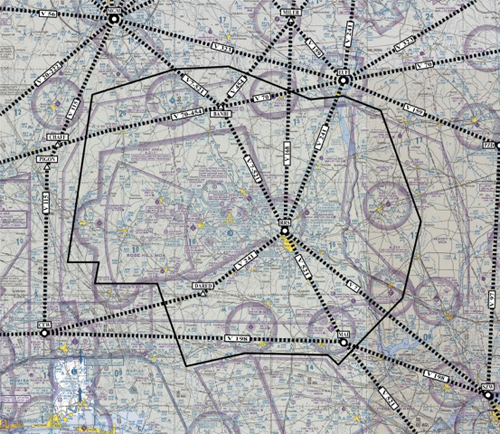DOTHAN AL- Sometime in the next several weeks the Dothan
Tower and Cairns Approach are slated to reduce their respective hours of
operation. Cairns Approach may be closed on weekends and from midnight to 7 AM
during the week; Dothan Tower is expected to be closed on weekends and much of
the night. When these facilities are closed, it will change the manner in which
the users of this airspace conduct operations safely.
When Dothan Tower is closed, its Delta airspace will become
Echo to the surface. When Cairns is closed, the airspace reverts to
Jacksonville Center and their radar coverage will not extend below 5,000 feet.
These changes will require pilots to be more alert and we will have to work
harder to keep our heads in the game.

Do Not Use For Navigation. Information May Not Be Current.
The above graphic
shows just how extensive Cairns' airspace is. When operating below 5,000' we
may need to become much more familiar non-compulsory reporting points such as
BANBI, PIGON, and DARED; in some situations they may become "compulsory."
Let's review some procedures that we in this part of the
country haven't used in many years. First, VFR below 5,000 feet, then IFR in
VMC, and finally, IFR in IMC.
VFR Below 5,000 Feet in Cairns and Dothan Tower Airspace As shown in the above graphic, Cairns Approach controls a large swath of airspace in southeast Alabama and adjacent slices of Georgia and Florida: from Mariana to Troy and from just south of Eufaula to Florala. Until now, the Cairns Controllers have provided Flight Following services when asked, almost without exception. These services have been especially helpful for traffic and weather advisories. Below 5,000', when Cairns is closed, these services will not be available.
When Dothan Tower is closed, use the Tower frequency as the CTAF. Good radio courtesy becomes even more important than usual; listen before transmitting; be patient; look, look, look. A recent FAASafety.gov email contained these words of advice and helpful links to review when operating at airports with newly closed Towers:
There are many resources that provide advisory information for operations at airports without an operating control tower. These include the FAA Aeronautical Information Manual (AIM), Advisory Circular (AC) 90-66A , CFR 91.113 (Basic Right of Way Rules),CFR 91.126 and CFR 91.127 (Traffic Flow Rules at Non-Towered Airports).
IFR in VMC When Cairns Approach is closed, we'll be talking with JAX Center. When we are below 5,000', JAX will not see us nor can they provide us with conflicting traffic or weather information. Welcome back to 1955! As always, when we are in VMC collision avoidance is "see and avoid" but now it will be without radar traffic advisories. Also, of course, JAX Center is unable to provide us with helpful and time-saving vectors to a final approach course or any other place.
If you are VMC and have the airport in sight, I suggest you cancel your IFR flight plan. JAX Center will not be able to release departures until you are out of the system and if you are going in to a non-Towered airport it is generally easier to cancel in the air. Plus, you need to be on CTAF anyway to begin getting the picture there. Also, if you stay in the system, you may find yourself being cleared for the full approach and its concomitant extra time and fuel burn. On the other hand, it is important to remember that when a class E surface area has reported weather below VFR, an early cancelation is not prudent. A Special VFR clearance or an IFR Visual or Contact Approach would be required to continue to the landing. Also, at a non-Towered airport there is no helpful Tower Controller to automatically cancel your IFR flight plan. The additional time taken to contact Flight service or the Center adds to the delay for the next arriving aircraft.
IFR in IMC The good news about IMC is that the non-instrument rated pilots should be on the ground so that part of the collision avoidance effort is mitigated. However, since vectoring will not be available, I'm expecting a lot more approach clearances to be for the full published approach. And, if you are not totally alone in that part of the sky, I would expect to get more holding patterns and stacking in obscure places. Start out with plenty of gas and know precisely when it is time to divert to a suitable alternate.
Departing IFR into IMC you will need to get your clearance with a void time via cell phone prior to takeoff. The U.S.-wide Clearance Delivery phone number for FSS is 888-766-8267. You will be departing into a non-radar routing, so expect delays while you and other aircraft are kept separate the old fashioned way: time and position reports. Once Center has you in radar contact at about 5,000', you will be welcomed back into the 21st Century and cleared on your way as previously filed.
A Closing Thought As we move into this old non-radar world, I would not be
surprised to be asked for one or more of those old 1955 position reports. I
checked the enroute chart for Cairns' airspace and found no compulsory
reporting points but lots of the non-compulsory type. Do you remember the
format for a full position report? "JAX Center, Cirrus 456 at DARED at 1434,
4,000', estimating Crestview at 1449, LOXLY next." (Reference AIM 5-3-2.) The old
low frequency 4-course radio ranges used to broadcast weather reports from
nearby airports on the hour and half hour. These broadcasts always ended with,"Keep alert and watch for other traffic." Still good advice. - Bill Castlen and
Rick Rehms, April 2013 for Alabama Aviator.com
-Bill Castlen is a CFII in the Dothan area and has been
instructing since 1955.
-Rick Rehm is the Training Supervisor at Cairns Approach.
















